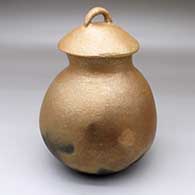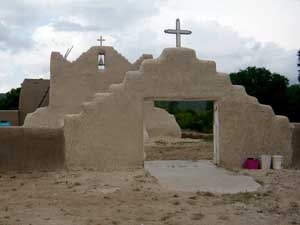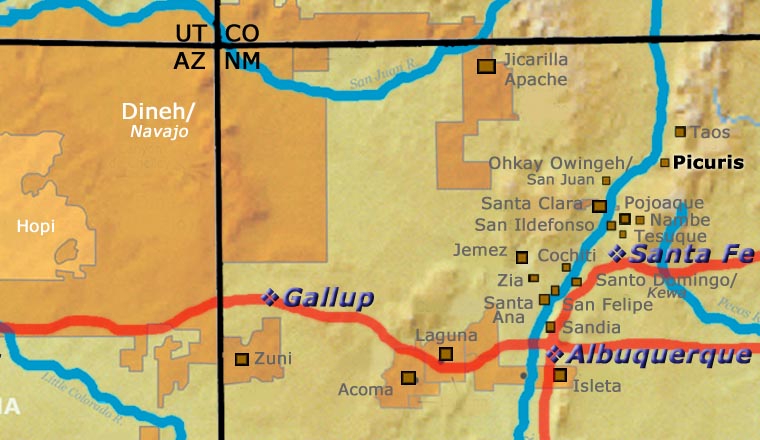
Cecilia A. Martinez
Picuris

Cecilia A. Martinez is the daughter of Ramita Simbola Martinez, one of the women who kept pottery making alive at Picuris Pueblo through the early 1900s. Ramita was famous for her micaceous pottery and that's what Cecilia learned how to make as she was growing up.
100 West San Francisco Street, Santa Fe, New Mexico 87501
(505) 986-1234 - www.andreafisherpottery.com - All Rights Reserved

Picuris

San Lorenzo de Picuris Mission
Picuris Pueblo was larger than Taos Pueblo when the Spanish first arrived in northern New Mexico. Around 1250 CE, some kind of schism developed at the significantly older Pot Creek Pueblo. Part of the pueblo was burned and the whole village was shortly abandoned. The people from there went primarily in two directions. There was already a small pueblo where Taos is now and about half the people went there, merging into that village. The other half of the people, those who became "Picuris," moved to a location about 25 miles southeast of Taos in a high mountain pass. The location was most likely chosen for the increased trading possibilities with the Utes, Comanches and Apaches who often ventured through the pass for raiding and trading purposes. It was that kind of traffic that made Taos great and the Picuris leveraged their new location to become greater yet.
On first sight, Spanish explorer Don Juan de Oñaté referred to the village as the "Grande Pueblo de Picuris." Reports from other Spaniards who visited the area in the late 1500s claim the original pueblo structure was as much as nine stories tall with as many as 3,000 residents. Realistically, it was more like four or five stories high and housed maybe 1,500 inhabitants.
Back then Picuris was a large and relatively powerful pueblo. The Spanish arrival was a major threat to their power and lifestyle. Because of the central bloody role Picuris Pueblo played in the Pueblo Revolt of 1680, when the Spanish returned in 1692 they looted, burned and leveled the pueblo. The residents scattered, some to other pueblos, some to the Cuartelejo area on the plains of eastern Colorado and western Kansas. Eventually the people returned and began rebuilding in a new location around 1706. But the pueblo's spirit had been broken and Picuris has never returned to its former glory.
In the center of today's Picuris Pueblo is the San Lorenzo Mission, built in the 1770s. After years of water damage, in the 1980s it was feared that the church would collapse soon. Inspectors decided the building couldn't be saved and had to be torn down. Tribal members then spent the next eight years using traditional methods to rebuild the church on the existing foundation. The original Picuris pueblo site (the one destroyed by the Spanish) was excavated in the 1960s and is now a protected archaeological site.
In the years after Pot Creek Pueblo was abandoned, the potters of both Taos and Picuris were making black-on-gray/white mostly utilitarian pottery. Sometime around 1400 CE, some of the potters of both Picuris and Taos Pueblos began working with clay high in mica content. This micaceous clay creates a distinctive metallic luster that sets their pottery apart from virtually all other pueblo pottery. In addition, micaceous pots and bowls are the only pueblo pottery that can be put directly on a fire or stove for cooking purposes. The Tewa Pueblos to the south sometimes copied the Taos/Picuris styles but they used different clays and tempers and achieved different results.
Taos and Picuris pottery is very similar. The main difference between them is that unpainted functional Picuris pots tend to be thinner than similar Taos pots. On some of their pots Picuris potters coat the pot with a slip of mica before it is fired. Often the fire clouds produced in the firing process are a pot's only decoration. Sometimes Picuris potters would add raised rope or inlaid beads or molded clay animals to their pots. They also produced an amount of striated pottery, the striations being achieved through various physical means.
In the old days, local Hispanic villagers often purchased Picuris functional pottery for household use. While the unpainted functional micaceous pottery has been in production since about 1600, it really dominated Picuris production after the Pueblo Revolt of 1680. In many ways the Picuris potters copied the plain pots of their new Jicarilla Apache neighbors (the Jicarillas arrived in the neighborhood not long before the Spanish). Picuris potters produced a fair amount of their traditional pottery styles until their primary source of micaceous clay was almost destroyed by an industrial mica-mining project. Loss of that clay source nearly ended the Picuris pottery tradition.
More recently Anthony Durand took on the job of trying to revive the Picuris pottery tradition after his grandmother led him to a new source of micaceous clay. Sadly, Anthony passed on in 2009. These days, many non-Picuris artists are also using micaceous clay to create beautifully shaped pots, figures and sculptures. Recently there has been a movement among the pueblo potters to create more aesthetic and artistic styles of pottery using micaceous clays. They hope this effort will create a market for their pottery as works of art rather than just functional utility ware.
100 West San Francisco Street, Santa Fe, New Mexico 87501
(505) 986-1234 - www.andreafisherpottery.com - All Rights Reserved
